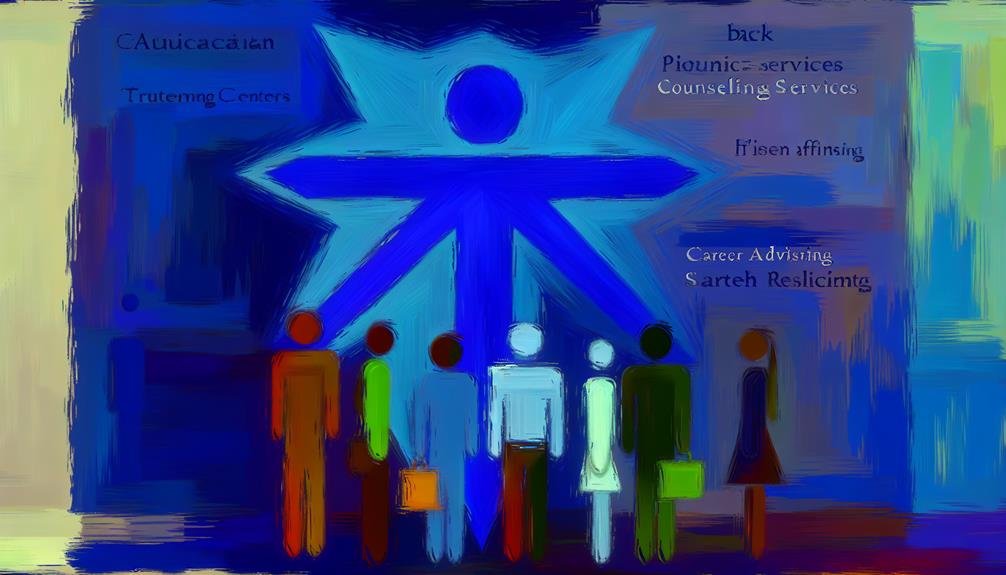Stanford University sparkles with academic brilliance and vibrant campus life. Pros? Renowned globally and commitment to excellence. Think 5:1 student-to-faculty ratio, exceptional faculty, and real-world research impact. Plus, diverse dorm options and over 650 clubs for extracurricular fun. But hey, every gem has its facets. Cons include high living costs, big class sizes, and a pressure-cooker atmosphere. Yet, Stanford offers robust aid, career opportunities in Silicon Valley, and fantastic student support services. Intrigued? Stay tuned for more insights on this gem!
Takeaways
- Academic excellence with distinguished faculty and research opportunities.
- Strong career prospects in Silicon Valley tech industry.
- Financial aid programs to alleviate high cost of living.
- Vibrant campus life with diverse dormitory options and activities.
- Supportive student services promoting well-being and inclusivity.
Pros of Stanford University
Stanford University stands as a renowned institution globally, celebrated for its academic prominence and pioneering research endeavors. One of the standout features of Stanford is its steadfast commitment to academic excellence. Students are immersed in a culture that nurtures intellectual curiosity and pushes boundaries, fostering a love for learning that extends far beyond the classroom.
Moreover, the university boasts a diverse community that enriches the collegiate experience. With a myriad of clubs and organizations catering to various interests, students find a welcoming and inclusive environment that encourages collaboration and understanding. This vibrant mosaic of backgrounds and perspectives not only enhances the educational journey but also shapes individuals into well-rounded global citizens.
Furthermore, Stanford’s dedication to providing financial aid opportunities sets it apart. With a significant portion of students benefiting from financial assistance, the university ensures that no deserving student is hindered due to monetary constraints. This commitment to accessibility and equity underscores Stanford’s ethos of empowering all individuals to reach their full potential.
Cons of Stanford University
Facing challenges such as large introductory course sizes and underrepresentation in certain demographics, Stanford University grapples with various drawbacks that affect the overall student experience.
The competitive academic environment at Stanford, while fostering excellence, can sometimes create a pressure-cooker atmosphere, leading to stress and impacting student well-being. Additionally, the high cost of living in Silicon Valley adds another layer of complexity, with students facing steep expenses for housing, meals, and transportation. This financial burden can be overwhelming, especially for those without substantial financial resources.
Furthermore, underrepresentation in demographics at Stanford not only affects the diversity of perspectives in discussions but also impacts the sense of belonging for some students. It is crucial for universities to create inclusive environments where all students feel valued and heard. Stanford must continue its efforts to address these challenges, aiming for a more balanced and supportive campus community.
Academic Excellence at Stanford

With a student-to-faculty ratio of approximately 5:1 and a diverse range of academic fields, Stanford University cultivates an environment conducive to academic excellence. Stanford’s commitment to academic excellence is evident through its distinguished faculty members, including Nobel laureates and Pulitzer Prize winners, who bring a wealth of expertise and knowledge to the university. These exceptional educators not only inspire students but also actively engage in groundbreaking research projects, providing students with the opportunity to participate in cutting-edge initiatives that have real-world impact.
Moreover, Stanford’s emphasis on a multidisciplinary approach to learning encourages students to explore various fields and perspectives, fostering a holistic and well-rounded education. The university’s significant research funding further enhances the academic experience, enabling students to thoroughly investigate their areas of interest and contribute meaningfully to their chosen fields.
Campus Life at Stanford
Stanford University’s campus life is as dynamic as it gets, offering a plethora of dormitory options that cater to various student preferences. Whether you’re into sports, arts, or entrepreneurship, Stanford’s extracurricular activities are sure to keep you engaged and exploring new passions.
Dormitory Options at Stanford
The diversity of dormitory options available at Stanford University enriches the campus living experience, offering students a range of unique communities and amenities to enhance their time at the university.
From traditional residence halls to co-op housing and themed houses, Stanford provides a plethora of choices for students to find their perfect fit.
Each dormitory at Stanford has its own character, creating a vibrant mosaic of living experiences on campus.
The residential life at Stanford goes beyond just a place to sleep; it fosters a strong sense of community and belonging among students, making the university feel like a home away from home.
Living in these dormitories opens up opportunities to engage in social activities, build lasting friendships, and participate in exciting on-campus events.
Stanford’s dormitory system is not just about providing a place to rest; it’s about creating a lively and supportive environment that promotes student interaction, personal growth, and unforgettable memories.
Extracurricular Activities Available
Engaging in a vibrant array of extracurricular activities at Stanford University broadens students’ horizons and enriches their campus experience. With over 650 student organizations to choose from, there’s something for everyone at Stanford. From academic clubs to cultural groups, sports teams to community service initiatives, the campus buzzes with energy and opportunities for students to explore their passions and interests.
Annual events like the Stanford Viennese Ball add a touch of elegance and sophistication to campus life, providing cultural and social experiences that students cherish. The Multicultural Spring Fest further enhances the vibrant campus atmosphere by celebrating diversity and bringing together students from over 90 countries, fostering a truly global community.
Whether you’re into arts, sports, volunteering, or just looking to meet like-minded individuals, Stanford’s extracurricular activities cater to all interests and backgrounds, ensuring that every student can find their place and make the most of their university experience.
Financial Considerations

When evaluating the financial aspects of attending Stanford University, it is important to take into account the various forms of aid available to students. Stanford University stands out for its robust financial aid programs, with a whopping 82% of students receiving some form of aid. This is a game-changer for many considering the high cost associated with attending such a prestigious institution. The average first-year financial aid package of $41,415 at Stanford helps alleviate the burden on students and their families, making Stanford more accessible to a wider range of students, regardless of their financial situation.
Moreover, with 91% of students living on-campus, Stanford helps reduce off-campus living costs and creates a vibrant community that enhances the overall college experience.
Additionally, Stanford’s commitment to financial inclusivity is evident in its efforts to keep student debt lower than the national average post-graduation. Scholarships, grants, and work-study opportunities further alleviate the high tuition fees, making Stanford a feasible option for a diverse student body.
Career Opportunities
Considering Stanford University‘s strategic location in Silicon Valley and its strong ties to top tech firms, the discussion now shifts to the abundant career opportunities available to students and graduates. Stanford offers a gateway to the bustling tech scene of Silicon Valley, where innovation thrives, and job prospects are aplenty. The university’s proximity to leading tech companies makes it a hotbed for internships and job placements, giving students a head start in their careers.
Moreover, Stanford’s extensive alumni network, comprising successful entrepreneurs and industry leaders, serves as a valuable resource for mentorship and career guidance. The connections forged at Stanford often lead to exciting job opportunities and collaborations in the tech industry. Additionally, the Career Education Office at Stanford provides dedicated support to students, assisting them in securing internships, job placements, and fostering professional development.
The culture of innovation and entrepreneurship at Stanford further enhances career opportunities, fostering a vibrant ecosystem for startup culture and research commercialization. Students and graduates are encouraged to think outside the box, pursue their entrepreneurial dreams, and make meaningful contributions to the tech world.
Student Support Services

Amidst Stanford University’s dedication to student success and well-being, a variety of comprehensive support services is available to guarantee a holistic and enriching academic experience for all students.
From academic advising to mental health services, Stanford has got your back! Need help figuring out which classes to take or exploring potential career paths? No worries, the university offers excellent academic advising to guide you through your academic journey.
Feeling stressed or overwhelmed? Stanford’s mental health services are here to assist you and safeguard your well-being.
But wait, there’s more! Stanford doesn’t just stop at academic and mental health support; the university goes above and beyond with its student support services. With programs like BeWell focusing on physical health and the Office of Accessible Education ensuring inclusivity for students with disabilities, Stanford truly fosters a culture of care and support.
And with a student-to-faculty ratio that allows for personalized attention, you can rest assured that Stanford has your best interests at heart.
Frequently Asked Questions
Are There Any Famous Alumni From Stanford University?
Stanford University boasts a prestigious list of alumni, including prominent figures like Elon Musk, Larry Page, Sergey Brin, Jennifer Siebel Newsom, Chelsea Clinton, and John F. Kennedy, Jr. These individuals have made significant contributions in various fields.
What Is the Student-To-Faculty Ratio at Stanford?
The student-to-faculty ratio at Stanford University is approximately 5:1. This ratio promotes personalized attention, strong mentorship, research collaborations, and a supportive learning environment. It facilitates small class sizes, individualized guidance, and enhanced academic engagement.
Does Stanford Offer Study Abroad Programs?
Stanford University offers a wide range of study abroad programs, including the Bing Overseas Studies Program (BOSP), providing students with immersive academic experiences in various countries. These opportunities enrich students’ global perspectives and educational journey.
How Diverse Is the Student Population at Stanford?
Stanford University boasts a richly diverse student population, with representation from over 90 countries and about 43% of undergraduates identifying as ethnic minorities. This commitment to diversity fosters a respectful and inclusive campus community.
What Are the Most Popular Extracurricular Activities at Stanford?
At Stanford University, the most popular extracurricular activities include performing arts groups, community service organizations, and cultural clubs. With over 650 student organizations, students can engage in a diverse range of interests and passions.
Conclusion
To sum up, Stanford University offers a top-tier education with a vibrant campus life and endless career opportunities.
While the cost may be a concern for some, the academic excellence and support services provided make it a worthwhile investment.
Whether you’re exploring the arts, sciences, or humanities, Stanford has something for everyone.
So, if you’re looking for a dynamic and enriching college experience, Stanford University may be the perfect fit for you.

